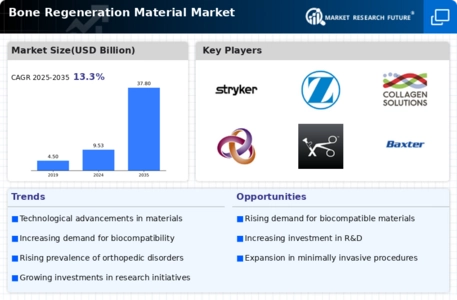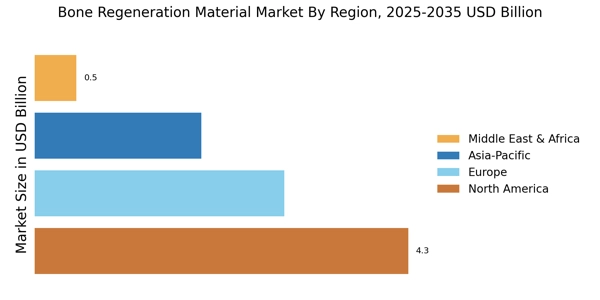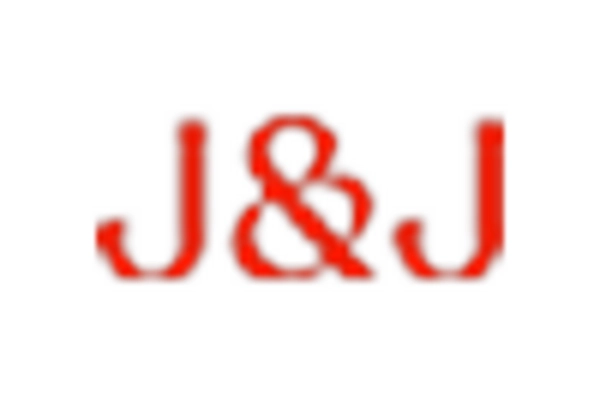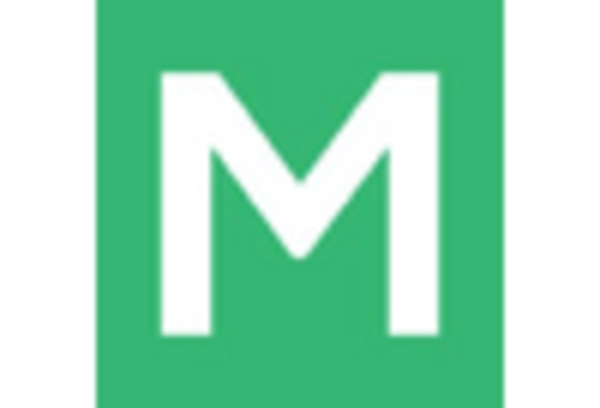Growing Aging Population
The demographic shift towards an aging population is a significant driver for the Bone Regeneration Material Market. As individuals age, the incidence of bone-related disorders such as osteoporosis and fractures increases, necessitating effective bone regeneration solutions. According to recent statistics, the global elderly population is expected to reach 1.5 billion by 2050, which will likely escalate the demand for bone regeneration materials. This growing demographic is not only increasing the prevalence of conditions requiring surgical intervention but also driving research and development in the field. Consequently, manufacturers are focusing on creating innovative materials that cater to the specific needs of older patients, thereby enhancing the overall market landscape. The implications of this trend suggest a robust growth trajectory for the Bone Regeneration Material Market in the coming years.
Rising Incidence of Bone Disorders
The increasing prevalence of bone disorders is a critical factor propelling the Bone Regeneration Material Market. Conditions such as osteoporosis, osteoarthritis, and traumatic fractures are becoming more common, leading to a heightened demand for effective treatment options. Recent studies indicate that approximately 200 million people worldwide suffer from osteoporosis, a condition that significantly increases fracture risk. This alarming statistic underscores the urgent need for advanced bone regeneration materials that can facilitate healing and improve quality of life. As healthcare providers seek to address these challenges, the market for bone regeneration materials is expected to expand, with a focus on developing innovative solutions that cater to diverse patient needs. The rising incidence of bone disorders thus presents a compelling opportunity for growth within the Bone Regeneration Material Market.
Surge in Sports Injuries and Accidents
The rising incidence of sports injuries and accidents is significantly influencing the Bone Regeneration Material Market. With an increasing number of individuals participating in sports and physical activities, the occurrence of fractures and bone-related injuries is on the rise. Recent data suggests that sports injuries account for nearly 30 million injuries annually in the United States alone, highlighting the urgent need for effective bone regeneration solutions. This trend is prompting healthcare providers to seek advanced materials that can facilitate quicker recovery and improve patient outcomes. As a result, the market for bone regeneration materials is expected to expand, driven by the need for innovative solutions that address the specific challenges posed by sports-related injuries. The surge in sports injuries thus represents a vital opportunity for growth within the Bone Regeneration Material Market.
Technological Innovations in Bone Regeneration
The Bone Regeneration Material Market is experiencing a surge in technological innovations that enhance the efficacy of bone healing. Advanced materials such as bioactive glass and calcium phosphate ceramics are being developed, which promote osteoconductivity and osteoinductivity. These innovations are not only improving patient outcomes but also expanding the range of applications for bone regeneration materials. The market is projected to grow at a compound annual growth rate of approximately 7.5% over the next five years, driven by these advancements. Furthermore, the integration of 3D printing technology is revolutionizing the customization of bone grafts, allowing for tailored solutions that meet individual patient needs. This trend indicates a shift towards more effective and personalized treatment options within the Bone Regeneration Material Market.
Increased Investment in Research and Development
Investment in research and development is a pivotal driver for the Bone Regeneration Material Market. As the demand for advanced bone regeneration solutions grows, companies are allocating substantial resources to innovate and improve existing materials. This trend is evident in the increasing number of collaborations between academic institutions and industry players, aimed at developing cutting-edge technologies. For instance, recent funding reports indicate that R&D investments in biomaterials are projected to exceed USD 1 billion by 2026. Such financial commitments are likely to accelerate the introduction of novel products that enhance bone healing and regeneration. The focus on R&D not only fosters innovation but also strengthens the competitive landscape of the Bone Regeneration Material Market, positioning it for sustained growth.


















Leave a Comment